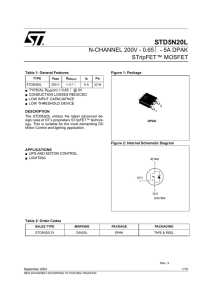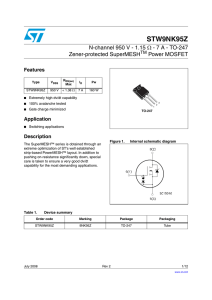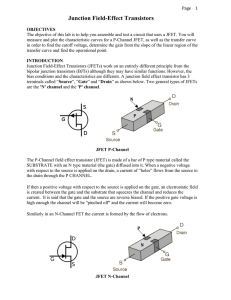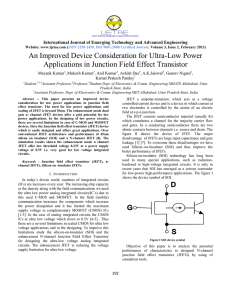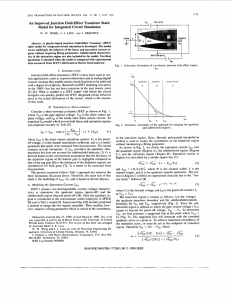Junction Field Effect Transistors (JFETs)
advertisement
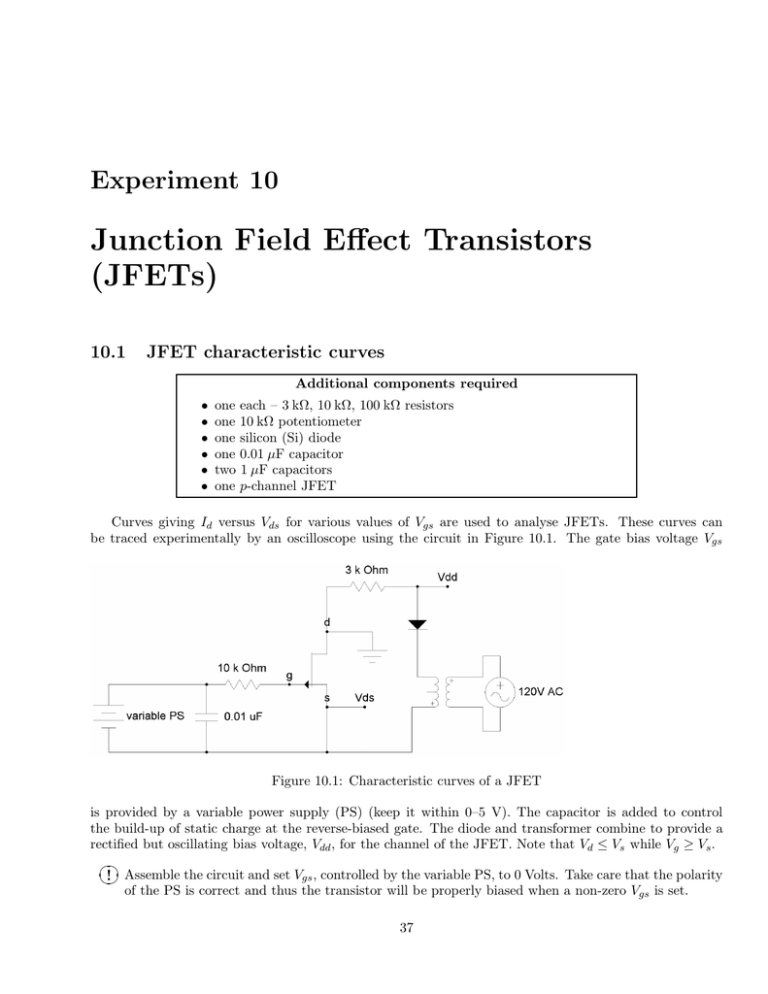
Experiment 10 Junction Field Effect Transistors (JFETs) 10.1 JFET characteristic curves Additional components required • • • • • • one each – 3 kΩ, 10 kΩ, 100 kΩ resistors one 10 kΩ potentiometer one silicon (Si) diode one 0.01 µF capacitor two 1 µF capacitors one p-channel JFET Curves giving Id versus Vds for various values of Vgs are used to analyse JFETs. These curves can be traced experimentally by an oscilloscope using the circuit in Figure 10.1. The gate bias voltage Vgs Figure 10.1: Characteristic curves of a JFET is provided by a variable power supply (PS) (keep it within 0–5 V). The capacitor is added to control the build-up of static charge at the reverse-biased gate. The diode and transformer combine to provide a rectified but oscillating bias voltage, Vdd , for the channel of the JFET. Note that Vd ≤ Vs while Vg ≥ Vs . ☛✟ Assemble the circuit and set Vgs , controlled by the variable PS, to 0 Volts. Take care that the polarity !✠ ✡ of the PS is correct and thus the transistor will be properly biased when a non-zero Vgs is set. 37 38 EXPERIMENT 10. JUNCTION FIELD EFFECT TRANSISTORS (JFETS) ☛✟ Switch the oscilloscope to xy-mode and connect Vds to the x-input of the scope and Vdd to the y!✠ ✡ input, using the drain (d) terminal as the common. Vdd is proportional to Id , but with a negative sign: Vdd = −3 × 103 Id . Press the Invert button on the y-channel of the scope to compensate for this. The characteristic curve will now be displayed. Adjust the position of the beam and the amplification in the two channels for best display, i.e. so that the curve covers most of the screen. Be sure the voltage settings are on calibrated positions. ☛✟ Measure the positions of a few judiciously chosen points, and reproduce the curve of Id versus Vds in !✠ ✡ a plotting program. ☛✟ Repeat for Vgs = 0.25, 0.5, 0.75, 1.0 V etc. to generate a family of curves (or a 3D surface plot). !✠ ✡ Vary Vgs up to the pinch-off voltage, where Id = 0. Record the pinch-off voltage. ☛✟ In the saturation region, ∆Id /∆Vds ≈ 0. Use the spacing between the two curves in the middle of !✠ ✡ the family of curves to determine the forward transconductance: gf s = ∆Id , ∆Vgs for Vds = const. ? In the pinchoff region, for low values of Vds , the drain current Id increases approximately linearly with Vds . In this region the FET acts like an ohmic resistance that can be controlled by varying Vgs . Calculate the output transconductance, gos = ∆Id , ∆Vds for Vgs = 0.5 V. What is the active output resistance, Rds , indicated by gos ? 10.2 Self-biased JFET amplifier A p-channel JFET amplifier requires that Vg > Vs > Vd . With the source connected to ground, the gate needs to be biased with a positive voltage Vgs while Vd needs a negative voltage for proper operation. The self-biased amplifier removes the need for bipolar voltage sources by shifting the levels at the gate and source pins. The gate resistor pulls the gate to ground when there is no input signal. The source resistor Rs sets the operating point by biasing the source negative with respect to the gate with a voltage Vgs . Use the center tap and one of the side taps of a 10 kΩ potentiometer for the source resistor, Rs . ☛✟ Assemble the circuit in Fig. 10.2 and connect the oscilloscope to measure the input (Vin ) and output !✠ ✡ (Vout ) voltage on x-channel and y-channel, respectively. Use a variable power supply as Vdd , and make note of its polarity. Set the FG to provide a 10 kHz sine wave. ☛✟ To determine the operating Q (quiescent) point, apply a large input voltage so that Vout is distorted. !✠ ✡ Now adjust Rs until the distortion is split equally between upper and lower limits. The transistor should now be positioned at a satisfactory Q-point. Turn off the FG and measure Vgs , Vds , and Rs . Be sure to disconnect Vdd while measuring Rs . ? Determine the load equation and plot it on the characteristic curves. Using the values determined experimentally in the previous step, place your Q-point on the load line and verify that it falls approximately in the middle of the linear region. 10.2. SELF-BIASED JFET AMPLIFIER 39 Figure 10.2: JFET amplifier ☛✟ Using a 0.5 V peak-to-peak vin , measure Vout and calculate the gain A = Vout /Vin . Increase Vin until !✠ ✡ just below the distortion first appears, and repeat the measurement of A. ☛✟ Now remove Cs and re-measure A. !✠ ✡ ? What is the benefit of Cs ? ? Use the intersection points of the load line with the characteristic curves on either side of the Q-point to estimate A. Compare this value with the one obtained experimentally in the previous step. 40 EXPERIMENT 10. JUNCTION FIELD EFFECT TRANSISTORS (JFETS)



